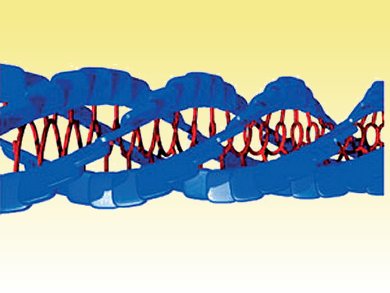Well-defined arrays of chromophoric molecules have attracted great interest because of their potential application in the fields of molecular photonics. Robust systems are needed to integrate phthalocyanine dye molecules into materials in which energy transfer between the units is possible over large distances.
A covalent strategy to prepare long and well-ordered arrays by grafting them onto a rigid and well-defined helical polyisocyanide backbone has been exploited by researchers based in Spain and The Netherlands. They applied copper(I)-catalyzed 1,3-dipolar cycloaddition of polyisocyanopeptides bearing acetylene groups with a zinc(II) phthalocyanine azide resulting in the synthesis of rigid rod polyisocyanopeptides having phthalocyanine dyes as pendant groups (see figure). Tomás Torres and co-workers report that the longest well-defined phthalocyanine assembly was thus syntheized.
Techniques such as UV/Vis, fluorescence, and CD spectroscopies were employed to confirm the helical arrangement of the array. In addition, through postfunctionalized of the polymer it was discovered that electronic interactions between the phthalocyanine units take place.
Image: © Wiley-VCH
- Postfunctionalization of Helical Polyisocyanopeptides with Phthalocyanine Chromophores by “Click Chemistry”,
I. López-Duarte, M. V. Martínez-Díaz, E. Schwartz, M. Koepf, P. H. J. Kouwer, A. E. Rowan, R. J. M. Nolte, T. Torres,
ChemPlusChem 2012.
DOI: 10.1002/cplu.201200087
This article is available for free as part of the ChemPlusChem free trial.
Find more records in the growing list of world records in chemistry in The Chemical Record and featured on ChemistryViews.




